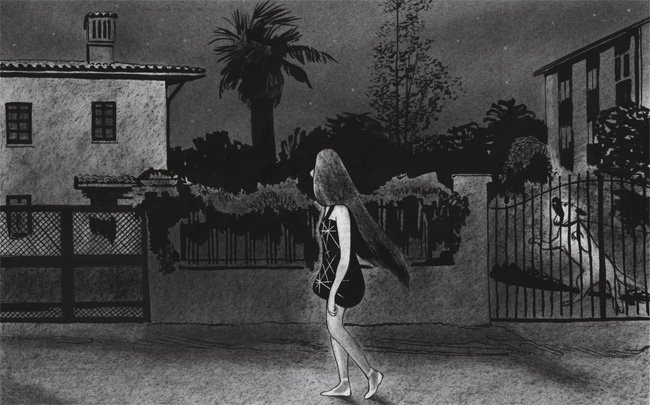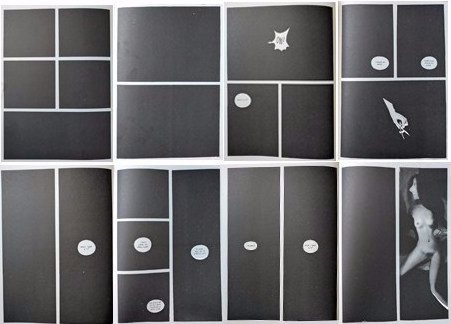Fior, Manuele, and Jamie Richards. The interview. Seattle, WA: Fantagraphics , 2017. Print.
ISBN: 978-1606999868
Hardcover

Following a calm drive through the Italian countryside of 2048, a car crash is visceral and jarring. Raniero exits the vehicle and climbs a short hill to find the triangles still drifting ethereally in the sky. They float behind power lines and you hear the distant throbbing sounds. Trees sway in the night breeze. Raniero laughs.
The Interview is Manuele Fior’s second graphic novel. An English translation was released April 2017, the original in Paris four years prior. Fior is an Italian cartoonist new to the American scene. He has lived in Germany, Norway, Egypt and France. Readers will be quick to notice a European sensibility.
I admit to being a comics reader that’s drawn to pretty pictures. The Interview does not disappoint. Fior uses a soft charcoal and ink aesthetic, rendered in black, white and gray, densely atmospheric with some experimental flourishes thrown in. This is a book where shadow is important. Think Caravaggio rather than Frank Miller. The characters are drawn with scratchy lines and often grotesque features, giving the pages a halting and abject quality. Overall there’s a nice balance of high and low art elements in The Interview, a balance you’d expect from an artist with roots in Europe and influences from around the world.

Despite the engaging and original art, The Interview borders on being a somewhat psychologically distant book, but this could be Fior’s style. Protagonists Raniero and Dora meet the day after Raniero’s car accident in a light-filled room at a mental hospital. Raniero is a psychologist and Dora is his newly admitted patient. She’s a member of The Convention, a youth movement that practices “emotional and sexual non-exclusivity.” Dora’s parents have sent her to the mental hospital because of her involvement with The Convention, but Raniero’s quick to address the more pressing issue. Dora believes she is in contact with extraterrestrials.
The unfolding events center on Raniero and Dora’s evolving relationship. In the beginning they seem to be complete opposites. Raniero is the professional, analytic, Old World voice of reason. Dora is the idealist youth, emotional and full of opinions. Raniero and Dora keep their distance at first but are drawn to one another. You get the sense that each needs what the other has. When the rest of the town starts seeing the mysterious triangles in the sky, Raniero must acknowledge that Dora could be telling the truth about her contact experiences. With an acceptance and tolerance typical of Western Europe, Dora and Raniero each in their own way embrace the coming changes in themselves and the world.
The Interview is carefully constructed without being stifling. The layout advances in surreal fashion. There’s no captions in the book and no narration. This gives the events a floating quality. Scene changes are noticeable but not abrupt and are often pieced together like a darkly luxurious dream. Fior is not against using less conventional methods. One sequence starts with two pages of entirely blacked-out panels followed by another six pages of inky darkness with a few speech balloons and sparse drawings thrown in (96-103). The device works well on the latter six pages but feels cumbersome on the first two where there’s nothing but solid ink. Blank panels disrupt pacing. You want to believe in Fior’s seven radiant panels of pure blackness, especially since the extended sequence through to page 115 benefits from the setup. With these seven panels Fior seems to be asking readers to slow down for something beautiful to come. I had to ask though, was two full pages of blackout panels too much? Perhaps European comic readers are well prepared to accept this device.
 Pages 96-103
Pages 96-103
As an American reader I admit to feeling a bit unconvinced in the effectiveness of these seven panels. For me, it took opening the book to pages 96-97 and letting it sit on the desk for half an hour to truly appreciate the depth and passage of time being presented. It’s easy to get lost in the black space if you look at it with different eyes, the way you would fine art in a gallery. How many comic book readers are going to interrupt the flow of the narrative in order to experience Color Field resonance? I didn’t the first time through. Maybe it’s a limitation of what comics theorist Neil Cohn would call my visual language. Cohn might say my inability to accept Fior’s blackout panels is a product of my own American Visual Language. If I had more exposure to visual languages that employ fine art and postmodern effects, I might be better able to make the smooth transition comic books require. Alright, lesson learned (I hope).
Fior has incorporated other devices that are less of a shock for pragmatic New World brains. There are recurring symbols, such as the triangles that everyone in the story presumes contain extraterrestrial beings. These appear repeatedly in the sky but also show up in a painting in Raniero’s house. Fior seems to like drawing water, whether it’s the ocean, a pond, or rain (his previous book, 5000 km Per Second, frequently features rain). Other symbols that repeat in the book include ripples in water, “homeopathic stones,” (Dora collects them), characters dreaming, and birds. Even Fior’s shadows seem to repeat, taking different shapes while conjuring almost sentient qualities from one page to the next. At times I assumed at least some of these symbols were being repeated purposefully. This is a psychological book influenced by Freud. The repetition of visual symbols contributes to the overall resonance and feeling that the subconscious is being probed.
Fior studied architecture and it shows. He even gave Raniero a Frank Lloyd Wright house, although no such house exists in Italy. His buildings and structures are carefully laid out in stark contrast to the way he draws characters, who at times feel haphazardly pasted into their clean(ish) environments. It’s a dynamic result that works. Rather than being distracting, the contrast aids what I kept calling the book’s dream pacing. The characters look all the more alive in the static landscapes of which they also seem separate. An existential malaise stalks the pages from beginning to end.

It would be sloppy to write a review of a book about aliens without mentioning their role. But The Interview isn’t really a book about aliens. It’s more of a Love/Self Discovery Story with a First Contact story in the background. Still there are some noteworthy extraterrestrial elements. At first the ET’s mostly seem to be a plot device, there to further Raniero and Dora’s relationship and also the events in town. As things progress, the ET presence begins affecting the townspeople. Dora says on page 156, “At first there was mostly lots of confusion…the signals unleashed very intense emotional responses.” This knowledge comes at the end of the book however when Dora is an old woman reflecting on the past. The “emotional responses” caused by the ET’s are rather understated through the majority of events depicted. There are some examples to be found but Fior could have pushed them much further. Psychological distance seems to be important to this author, not just with the analytic Raniero, but with the other characters too. Perhaps it would have been difficult for Fior’s characters to keep their distance if they were constantly displaying their emotions in an open manner. On 157, Dora says there was “no message to decipher,” and “it was only when we came to that realization that we were able to move on to the next phase.” She goes on to repeat the importance of strong emotional “charges.” So contact with extraterrestrials is about putting aside analytic rigor and developing an emotional connection. Is Fior telling us that even when his characters present a placid exterior they may be opening up on the inside?
ET stories have been popular for as long as we’ve had science fiction. There’s no denying the majority of new science fiction movies and books have been produced in only a few genres. Action and horror dominate the list. Are books like The Interview which depict aliens in different contexts rare? I hope they’re becoming less so. Science fiction has for too long been written mostly by sci-fi authors (imagine that). I believe it’s time for the genre to open its doors and give other kinds of writers and artists a chance. As popularity for science fiction grows, more voices coming to the table can only be a good thing. Fior himself admits he only recently became interested in the subject of extraterrestrials. In my opinion Fior’s book is not an alien story. It is a human one centered on people and their problems. His characters keep their distance but they do express a complex inner life, made more so by our friends in the skies.

Manuele Fior’s first book is 5000 km Per Second, a love story this time in watercolor, spanning four countries. Fantagraphics calls it “another delicate graphic novel masterpiece from Europe.”
A third book is set for production in 2018 under the same publisher. Blackbird Days is a collection of short graphic stories, ranging from a story told in the same world as The Interview, to stories about sons and fathers, couples, painters and even robots.
Advertisements Share this:




